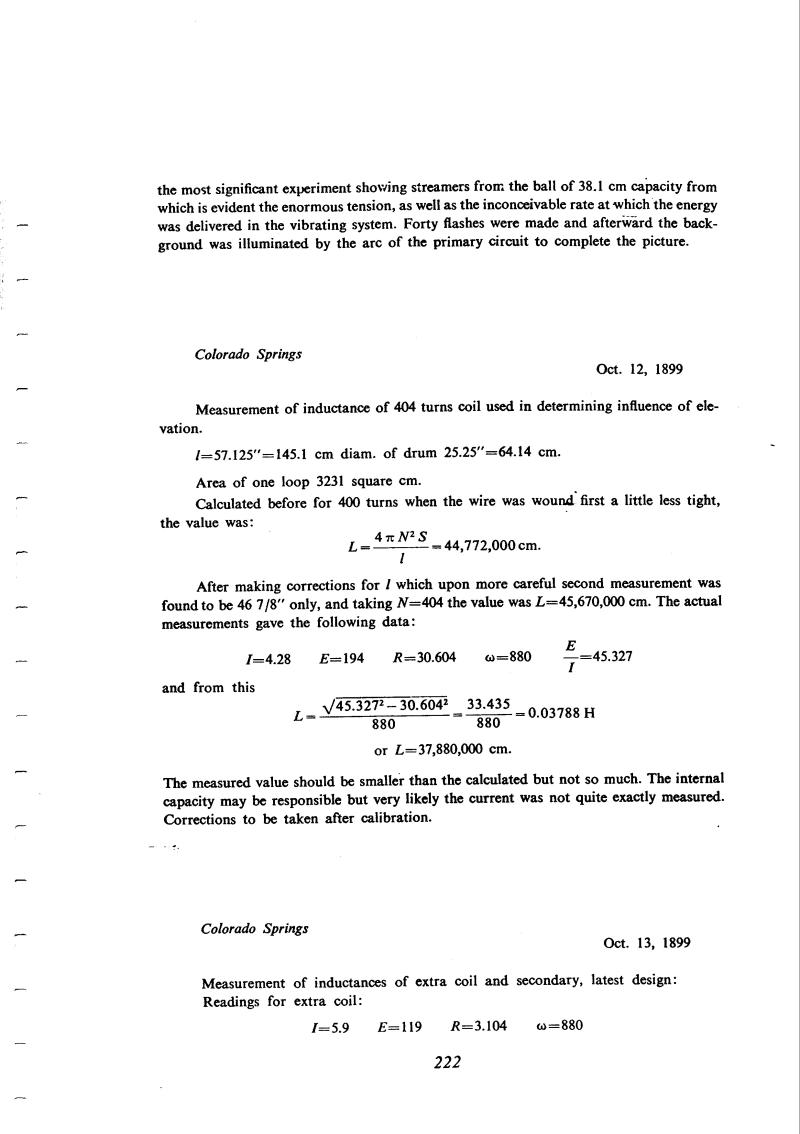
Nikola Tesla Books
the most significant experiment showing streamers from the ball of 38.1 cm capacity from which is evident the enormous tension, as well as the inconceivable rate at which the energy was delivered in the vibrating system. Forty flashes were made and afterward the background was illuminated by the arc of the primary circuit to complete the picture.
Colorado Springs
Oct. 12, 1899
Measurement of inductance of 404 turns coil used in determining influence of elevation.
l = 57.125" = 145.1 cm diam. of drum 25.25" = 64.14 cm.
Area of one loop 3231 square cm.
Calculated before for 400 turns when the wire was wound first a little less tight, the value was:
$! {L = {4 \pi N^{2} S \over l}} $! = 44,772,000 cm.
After making corrections for l which upon more careful second measurement was found to be 46 7/8" only, and taking N = 404 the value was L = 45,670,000 cm. The actual measurements gave the following data:
I = 4.28 E = 194 R = 30.604 Ï = 880 $! {E \over I} $! = 45.327
and from this
$! {L = {{\sqrt{45.327^{2} - 30.604^{2}}} \over 880} = {33.435 \over 880} = } $! 0.03788 H
or L = 37,880,000 cm.
The measured value should be smaller than the calculated but not so much. The internal capacity may be responsible but very likely the current was not quite exactly measured. Corrections to be taken after calibration.
Colorado Springs
Oct. 13, 1899
Measurement of inductances of extra coil and secondary, latest design:
Readings for extra coil:
I = 5.9 E = 119 R = 3.104 Ï = 880
222
October 11
Tesla obviously did not sleep much the previous night since he was photographing the oscillator in operation both late at night and early in the morning. The Nikola Tesla Museum in Belgrade possesses several photographs which date from this period, but they are too faded to be worth showing. One of the better preserved photos is shown on p. 221.
October 11
Last night Tesla obviously did not sleep much, because he was photographing the oscillator in operation. The photographs were made late in the evening and early in the morning. In the archives of Nikola Tesla museum, several photographs were found which originate from this period but they faded so much that it was not possible to show them. One photograph which is better than others could be seen on Page 221.
October 12-13
To calculate the inductance of cylindrical coils Tesla used the formula for a coil of infinite length, which always gave values too large, especially when the diameter: length ratio of the coil was not much less than unity. However, when the proper corrections are made (Russel(57)), the inductances obtained differ from Tesla's values by less than one percent.
October 12-13
Tesla measures the impedance of the "special coil", "additional coil", and oscillator secondary. He performs measurements at the frequency of approximately 140 Hz as per method used to determine the impedance module on the basis of voltage and current relationship. He does not explain how he measures resistance (he measured it on Oct. 10). The as found value for "special coils" was compared with the theoretical value determined by means of the equation for an infinitely long coil. The matching of these two values is poor, but this is not surprising because the ratio 1/d is small.

